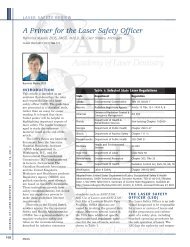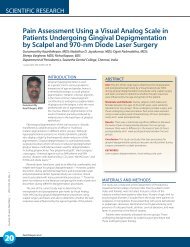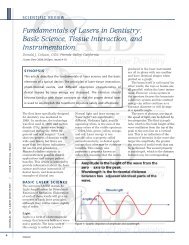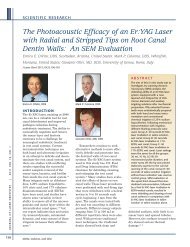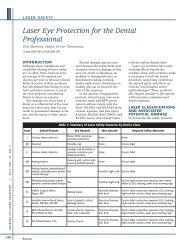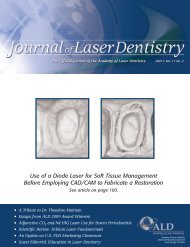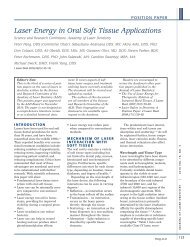You also want an ePaper? Increase the reach of your titles
YUMPU automatically turns print PDFs into web optimized ePapers that Google loves.
C A S E R E P O R T S<br />
Advantages <strong>of</strong> 980-nm Diode <strong>Laser</strong> Treatment<br />
in the Management <strong>of</strong> Gingival Pigmentation<br />
Mihir Khakhar, BDS, Postgraduate Student; Richa Kapoor, BDS, Postgraduate Student; N.D.<br />
Jayakumar, BDS, MDS, Pr<strong>of</strong>essor; O. Padmalatha, BDS, MDS, Pr<strong>of</strong>essor; Sheeja S. Varghese, BDS,<br />
MDS, Pr<strong>of</strong>essor; M. Sankari, BDS, MDS, Assistant Pr<strong>of</strong>essor<br />
Department <strong>of</strong> Periodontics, Saveetha Dental College, Chennai, India<br />
J <strong>Laser</strong> Dent 2011;19(3):283-285<br />
Mihir Khakhar, BDS<br />
I N T R O D U C T I O N<br />
The color <strong>of</strong> the gingiva is determined<br />
by several factors, including the<br />
number and size <strong>of</strong> the blood vessels,<br />
epithelial thickness, quantity <strong>of</strong> keratinization<br />
and pigments within the<br />
epithelium. Melanin, carotene,<br />
reduced hemoglobin, and oxyhemoglobin<br />
are the major pigments that<br />
contribute to the normal color <strong>of</strong> the<br />
oral mucosa. 1 Frequently, gingival<br />
hyperpigmentation is caused by<br />
heavy melanin deposition by<br />
melanocytes located in the basal<br />
layers <strong>of</strong> the epithelium. 2 Demand for<br />
cosmetic therapy <strong>of</strong> gingival melanin<br />
pigmentation is common and various<br />
methods have been used for depigmentation,<br />
each with its own merits<br />
and limitations. With the recent<br />
advances and developments in a wide<br />
range <strong>of</strong> laser wavelengths and<br />
different delivery systems, research<br />
suggests that lasers could be applied<br />
to periodontal, restorative, and<br />
surgical treatments.<br />
<strong>Laser</strong>s have the advantages <strong>of</strong><br />
easy handling, short treatment<br />
time, hemostasis, and bactericidal<br />
effects. They are used extensively<br />
for s<strong>of</strong>t tissue surgical procedures<br />
such as gingivectomy, frenectomy,<br />
sulcular debridement, and exci-<br />
sional and incisional biopsies. In<br />
the present case series an attempt<br />
was made to compare the healing,<br />
pain levels, and patient satisfaction<br />
during the treatment <strong>of</strong> gingival<br />
depigmentation using lasers,<br />
scalpel surgery, and electrocautery.<br />
Figure 1: <strong>Laser</strong> Depigmentation<br />
Figure 1a: Preoperative view showing<br />
diffuse melanin pigmentation<br />
Figure 1b: Intraoperative view showing<br />
de-epithelization performed with the<br />
laser in the maxillary and mandibular<br />
anterior region<br />
Figure 1c: Six-month postoperative view<br />
showing complete re-epithelization has<br />
occurred<br />
A B S T R A C T<br />
Gingival pigmentation is an<br />
aesthetic problem that <strong>of</strong>ten<br />
requires surgical removal. Recently<br />
there has been an increased use<br />
<strong>of</strong> hard and s<strong>of</strong>t tissue lasers in<br />
the field <strong>of</strong> dentistry. In the<br />
present case series, three cases<br />
which have been treated for<br />
gingival depigmentation using<br />
laser, scalpel surgery, and electrocautery<br />
techniques are presented.<br />
Healing, pain levels, and patient<br />
satisfaction in all three techniques<br />
are evaluated and compared.<br />
K E Y W O R D S<br />
Depigmentation, melanin pigmentation,<br />
electrocautery, laser<br />
C A S E 1<br />
A 25-year-old male presented with<br />
melanin pigmentation (Figure 1a).<br />
Topical anesthesia (lignocaine [lidocaine]<br />
hydrochloride, Lox 2% jelly,<br />
Neon Laboratories, India) was<br />
applied in the maxillary and<br />
mandibular anterior region.<br />
Depigmentation was carried out<br />
using a 980-nm diode laser<br />
(SIRO<strong>Laser</strong>, Sirona Dental<br />
Systems, Bensheim, Germany) set<br />
at a power <strong>of</strong> 2 W, in continuous<br />
mode, with a 300-micron fiber. The<br />
fiber tip was moved in a sweeping<br />
motion continuously from one site<br />
to another to avoid heat accumulation<br />
which could cause a<br />
postoperative burning sensation.<br />
Care was taken to maintain the<br />
physiologic contour <strong>of</strong> the gingiva<br />
during the procedure. All<br />
Khakhar, et al.<br />
J O U R N A L O F L A S E R D E N T I S T R Y | 2 011 V O L . 19 , N O . 3<br />
283





